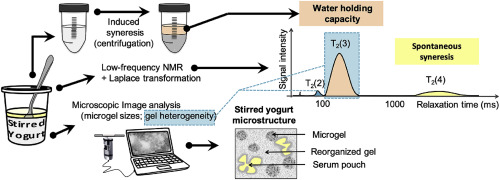当前位置:
X-MOL 学术
›
Food Hydrocoll.
›
论文详情
Our official English website, www.x-mol.net, welcomes your feedback! (Note: you will need to create a separate account there.)
Characterization of syneresis phenomena in stirred acid milk gel using low frequency nuclear magnetic resonance on hydrogen and image analyses
Food Hydrocolloids ( IF 10.7 ) Pub Date : 2020-09-01 , DOI: 10.1016/j.foodhyd.2020.105907 Audrey Gilbert , Laurie-Eve Rioux , Daniel St-Gelais , Sylvie L. Turgeon
Food Hydrocolloids ( IF 10.7 ) Pub Date : 2020-09-01 , DOI: 10.1016/j.foodhyd.2020.105907 Audrey Gilbert , Laurie-Eve Rioux , Daniel St-Gelais , Sylvie L. Turgeon

|
Abstract Water retention is an important quality attribute for yogurt. Classically, stirred yogurt water retention is investigated using induced syneresis measurement (centrifugation), which does not characterize spontaneous syneresis. Low-frequency nuclear magnetic resonance (1H-LF-NMR) is a non-destructive technique to detect spontaneous syneresis. Experimental yogurt from pasteurized skim milk, and commercial stirred yogurts were analyzed with 1H-LF-NMR. After Laplace's transformation of the signal, hydrogen atoms pools were differentiated according to their mobility. Each hydrogen pool stood for a type of water mobility in the matrices characterized by a relaxation time (T2(i)), and a signal intensity (I2(i)). Yogurt water retention was assessed by induced syneresis and their structure was characterized using microscopy. Low frequency 1H-NMR detected four different water mobility groups in the matrices. Among these, there was a signal from bulk water, and another attributed to the separated serum (spontaneous syneresis). In experimental yogurts, spontaneous syneresis was visible, resulting in induced syneresis higher than 50%. Moreover, induced syneresis and spontaneous syneresis detected by 1H-LF-NMR were similar. In commercial yogurts, bulk water mobility reduced with increasing protein content and protein network density. Induced syneresis and bulk-water mobility correlated only in yogurts without gelatin. In the presence of gelatin, the network was more open, probably favoring bulk water mobility. This study shows that 1H-LF-NMR associated with microscopy image analysis efficiently assesses and describes yogurts water retention and spontaneous syneresis.
中文翻译:

使用低频核磁共振氢和图像分析表征搅拌酸性乳凝胶中的脱水现象
摘要 保水性是酸奶的重要品质属性。传统上,使用诱导脱水收缩测量(离心)来研究搅拌酸奶的保水率,其不表征自发脱水收缩。低频核磁共振 (1H-LF-NMR) 是一种检测自发脱水收缩的无损技术。用 1H-LF-NMR 分析来自巴氏杀菌脱脂牛奶的实验酸奶和商业搅拌酸奶。在拉普拉斯对信号进行变换后,氢原子池根据其迁移率进行了区分。每个氢池代表矩阵中的一种水迁移率,其特征在于弛豫时间 (T2(i)) 和信号强度 (I2(i))。通过诱导脱水收缩来评估酸奶的保水性,并使用显微镜表征其结构。低频 1H-NMR 在基质中检测到四种不同的水迁移率基团。其中,有一个来自散装水的信号,另一个归因于分离的血清(自发脱水收缩)。在实验酸奶中,可以看到自发脱水收缩,导致脱水收缩率高于 50%。此外,通过 1 H-LF-NMR 检测到的诱导脱水收缩和自发脱水收缩是相似的。在商业酸奶中,随着蛋白质含量和蛋白质网络密度的增加,水的流动性降低。仅在不含明胶的酸奶中诱导脱水收缩和大量水流动性相关。在存在明胶的情况下,网络更加开放,可能有利于大量水的流动。这项研究表明,与显微镜图像分析相关的 1H-LF-NMR 可以有效地评估和描述酸奶的保水性和自发脱水收缩。
更新日期:2020-09-01
中文翻译:

使用低频核磁共振氢和图像分析表征搅拌酸性乳凝胶中的脱水现象
摘要 保水性是酸奶的重要品质属性。传统上,使用诱导脱水收缩测量(离心)来研究搅拌酸奶的保水率,其不表征自发脱水收缩。低频核磁共振 (1H-LF-NMR) 是一种检测自发脱水收缩的无损技术。用 1H-LF-NMR 分析来自巴氏杀菌脱脂牛奶的实验酸奶和商业搅拌酸奶。在拉普拉斯对信号进行变换后,氢原子池根据其迁移率进行了区分。每个氢池代表矩阵中的一种水迁移率,其特征在于弛豫时间 (T2(i)) 和信号强度 (I2(i))。通过诱导脱水收缩来评估酸奶的保水性,并使用显微镜表征其结构。低频 1H-NMR 在基质中检测到四种不同的水迁移率基团。其中,有一个来自散装水的信号,另一个归因于分离的血清(自发脱水收缩)。在实验酸奶中,可以看到自发脱水收缩,导致脱水收缩率高于 50%。此外,通过 1 H-LF-NMR 检测到的诱导脱水收缩和自发脱水收缩是相似的。在商业酸奶中,随着蛋白质含量和蛋白质网络密度的增加,水的流动性降低。仅在不含明胶的酸奶中诱导脱水收缩和大量水流动性相关。在存在明胶的情况下,网络更加开放,可能有利于大量水的流动。这项研究表明,与显微镜图像分析相关的 1H-LF-NMR 可以有效地评估和描述酸奶的保水性和自发脱水收缩。



























 京公网安备 11010802027423号
京公网安备 11010802027423号